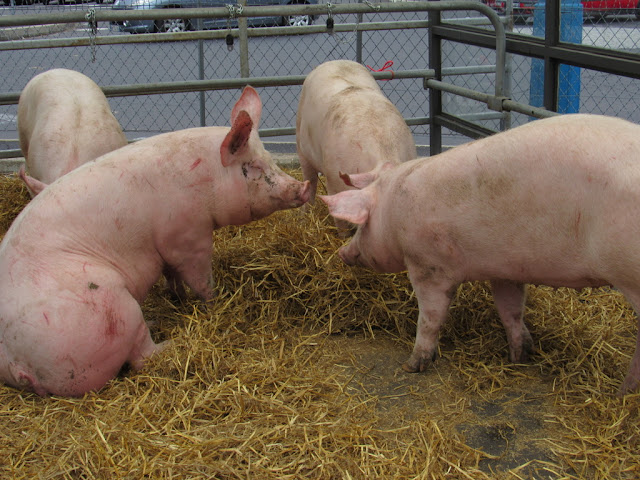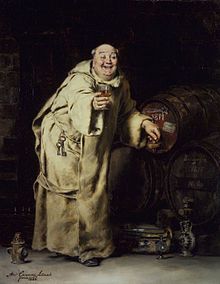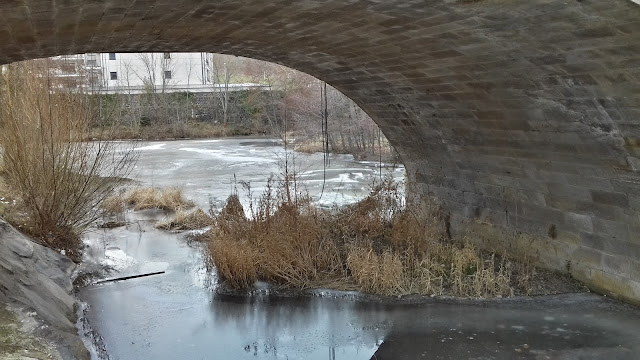One Sunday
afternoon in mid-March I went to St. Paulien where the local Kiwanis Club was holding a weekend “Salon du Vin.” The Salon is a wine tasting event where
several regional wine producers gather to show off their wares and try to gain
loyalty for their products. In addition to the wine producers are also
cheesemakers, saucisson makers, and those who can snails or foie gras or some other delectable
delight that goes well with wine.
As I entered
the Salon and approached the reception table, two Kiwanis volunteers in suits
leaped up awkwardly to greet me. Their movement reminded me of some movie I had
seen, and I had to hold my giggles. I spoke French to them, quite simple stuff
like “I’d like to buy a ticket for the Salon.” They (as all the French people
I’ve encountered these past eight months) were quite welcoming and pleased that
I, the étranger, would speak to them
in French. I payed my 3-euro entrance fee and they gave me a ticket and a wine
glass for the tasting.
 |
| my friend, Pascal who has taught me much about French culture |
I felt I was in
familiar territory because five months earlier I went to my first Salon with
Pascal, a Frenchman friend I met in Kalamazoo who now lives with his family in
the Savoie area (near Geneva, Switzerland). A former salesman of wine and
champagne, he knew his way around Salons. He even bought me a bottle of red
wine, a wedge of delicious cheese, a saucisson
(salami), and a small jar of snails. For himself, he bought several bottles
of wine and cheese. The Salon was a fun visit and apparently, a very French
thing to do. Voilá, I was going to try it again only on my own. I knew what to
do, and it was a community event that I wanted to support.
Since I’d been
through St. Paulien before (and even attended a “Salon du Chocolat” in November
where they had a chocolate tasting event), I knew where I was going. However,
wine is not my forte since I know
little more than it is red, white, and rosé, and that it is either dry or
sweet. There are many other distinctions, however, and plenty of wine producers
who want to help rookies learn about wine like the website: Wine Tasting for Beginners. The purpose in wine tasting classes is to “help you describe it better, taste it
smarter, pair it with the right food, and choose better bottles from the
supermarket in future,” according to a British website on le bon heure entitled
Experience Days.
I knew the
mechanics of wine tasting like smelling it, noting its color, swishing it
around the glass to check out its legs (i.e., its adherence to the glass),
taking a sip and letting it settle in my mouth. However, the more I did these
things at the various wine stalls, the more conspicuous I felt that I was a
fake who did know what I was doing.
Nevertheless, one
young producer was very kind to me. She explained in French (until I got that
blank look and she switched to English) that her vineyard was located just
north of Marseille and that her rosé was the family’s specialty. It surely
tasted good and I knew I liked it. She said it was “rond et sec” that is: round
and dry. I could taste the dry, but I had to ask her what “rond” meant. She
patiently told me that there was no sugar in the wine and that the taste was
derived only from the fruit. I nodded, but just couldn’t experience how it
differed from wine with sugar. I appreciated her willingness to talk with me,
though, and decided that I’d buy the rosé because
she spent so much time with me and
because she was located near Marseille, a city I want to visit sometime this
year.
I moved on to another
stall but was hard-pressed to make a choice. Most of the producers were shy and
didn’t look up, so it was easy to pass by them. There were a couple producers,
however, who invited me to taste their wine. One let me try wine from several
different bottles. They were all good, but when I asked what kind of wine it
was, he said it was Cote du Rhône. We buy this wine for the Centre, so I wasn’t
going to spend money on it because I wanted something different. I thanked the
producer and sheepishly slipped away.
My third and
last stop was with another young woman producer. This time I tried the red, the
white and the rosé. Before tasting her wine, she rinsed out my glass so that
I’d have a fresh taste of her wine and not a mix of someone else’s. Then she
offered me a spitting pot where she expected me to take a sip, slosh it around
in my mouth, and then spit it out. I could also dump the rest of the contents of my glass.
“Oh no,” I
said. “I’ll drink the whole sample that you gave me,” thinking I
didn’t want to waste good wine. After three or four samples, however, I was
getting whoosy and remembered that I had to drive home. (I had been warned
before I went to the Salon that the police like to hang out near these events
in an attempt to catch those who have had a few too many samples.) So I stopped
my wine tasting and asked the woman for a bottle of white wine mostly out of
guilt that she had taken so much time with me even though I knew that that was
why she was there.
 |
| layout of the Salon du Vin |
I toured the small
exhibit hall to look for the cheeses. Unfortunately, there was only one stall,
and the producers weren’t there. I would have gladly bought some cheese because
I’ve fallen in love with French cheese of which there are 365 varieties! I tend
to like bries, blues, and hard cheeses. I also know that I prefer cow cheese
although I’m slowly getting to like goat and sheep cheeses. Sadly, I left the
cheese stall but turned to an interesting-looking man who was dark, swarthy and
wore a red neckerchief.
“Voulez-vous une goûter?” he asked,
trying to engage me to approach his table. He had small bits of bread and a
number of jars full of something. He spread the stuff on the piece of bread and
offered it to me.
“Bien sûr,” I responded to him, quickly getting
the message that I was about to taste foie
gras (duck’s liver). I abhor liver of any kind, and I don’t like the fact that
they force feed the animals so that their liver enlarges and then they are
killed for it. But, I had to admit that this foie gras tasted good. I wondered if I had transformed my taste for
liver just being in France where everything tastes good.
“Here, try
another,” he said. By this time, he knew I was an English speaker and once
again, my quest to speak French to natives was foiled by their ability to speak
my language. It’s intriguing that it usually only takes a word or two before
the French know I am an English speaker.
“Are you from
England?” he asked. This is a typical question indicating that maybe there are
more British travelers to France than Americans.
“Non, je suis Américaine,” I answered
trying to remain in French language, proudly putting up my hand in the form of
the Michigan mitten and pointing out Detroit where I was born, and Kalamazoo,
where I live. “Il est à mi-chemin entre Detroit
and Chicago.”
“I am from
Basque country,” he said in near-perfect English while I was thinking how
unfair it is that so many people all over the world have learned English while
I’m still trying to learn French!
He offered me
four samples, but I determined that I liked the second one best. So I bought it
even though he tried to offer me a couple more samples. I didn’t want to press
my luck with foie gras.
“You are the
first Basque I’ve ever met,” I blurted out to him. He seemed unimpressed or
maybe he was just concentrating on working the charge card machine.
“You will like
that foie gras,” he said in his all-business-like way.
Actually, I hadn’t
intended to buy anything at the Salon, but ended up buying two bottles of wine
for 15 euros and a jar of foie gras
for 16 euros. But the feeling of being a fake combined with my fear of drinking
too wine told me it was time to go home. I could have spent more time at the
Salon and tried to learn more about wine, but I couldn’t sustain buying another
bottle of wine in order to allay my guilty feelings.
 Then I had to
approach my next challenge: the parking lot. This is always a particular trial
in France and today would be no different. I followed the same narrow road I had
taken when I entered the Salon, but was puzzled that I couldn’t find the way out
since there was an interdit sign (a red
circle crossed out, which means no entry) on the road that connected to the
complex of buildings where the Salon took place. In fact, there were two other
events going on: a soccer match and an indoor-outdoor flee market.
Then I had to
approach my next challenge: the parking lot. This is always a particular trial
in France and today would be no different. I followed the same narrow road I had
taken when I entered the Salon, but was puzzled that I couldn’t find the way out
since there was an interdit sign (a red
circle crossed out, which means no entry) on the road that connected to the
complex of buildings where the Salon took place. In fact, there were two other
events going on: a soccer match and an indoor-outdoor flee market.
I drove on an
adjoining road and discovered I’d encountered the soccer field where the match
was about to begin. So I re-traced my path back to the road that led to the
Salon du Vin. Maybe there was a way out of the complex in that direction that I
had missed. Wrong move! While I was able to get into the parking lot through
this narrow road that led to it, there was not enough space for two cars going
in opposite directions. Then a number of cars lined up wanting to go out. At
one point, I encountered a man who drove a battered, dull-green car. I signaled
with my hands that I didn’t know where to go since there were cars behind me.
He signaled back the same hand motion and then edged up nose to nose to me as
if to say that I had to yield to him. In what seemed like a forever stalemate,
the cars behind me suddenly started backing up. I followed them as the man in
the battered, dull-green car kept creeping closer and closer to me as though he
were afraid someone would cut in front of him. Finally, I reached the end of
the road that gave him enough room to slip past me, but not without scraping my
right fender a bit. This poor man was obviously in a hurry! I, in turn,
breathed a sigh of relief that the ordeal was over and that I could finally
leave.
The day had
been a bit edgy in that I felt I was out in French society left to my own
devices, but I made it through just fine. After all, I had had another French cultural
experience—as well as the opportunity to drive in the beautiful French
countryside. I doubt it gets any better than this!


 The pot-au-feu celebration was held courtesy of the Super U, which prepared and offered the meal for free (gratuit) as a community service project. It seemed that all of the people of Le Puy were there and Eluiza and I joined in on the fun!
The pot-au-feu celebration was held courtesy of the Super U, which prepared and offered the meal for free (gratuit) as a community service project. It seemed that all of the people of Le Puy were there and Eluiza and I joined in on the fun!











































